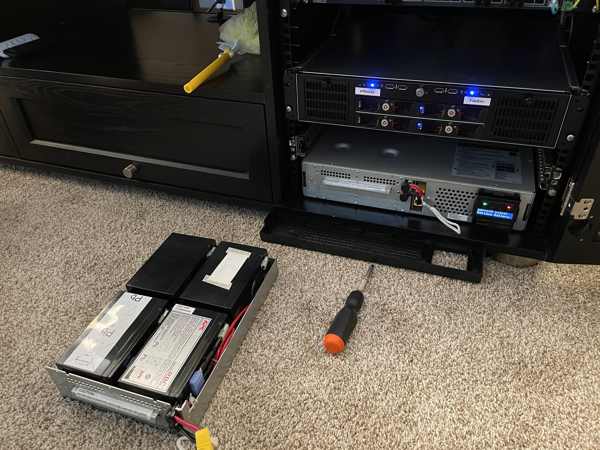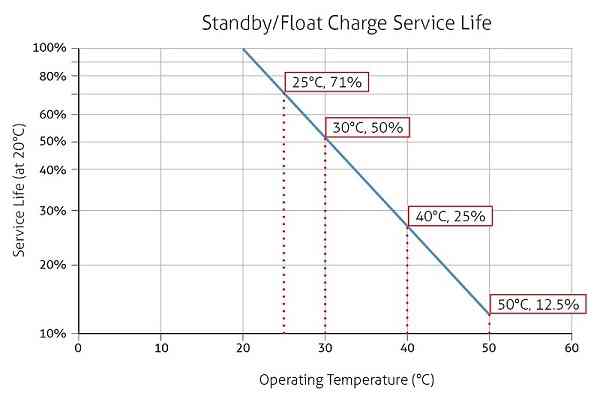Quelle est la durée de vie d'un mont de rack?
Lorsque vous investissez dans un support de rack professionnel (Alimentation sans interruption) Pour protéger votre équipement critique, Une question clé est, "Combien de temps durera cet investissement?" Comprendre l'espérance de vie de vos UPS est crucial pour la budgétisation et la garantie de vos systèmes. Il est important de penser à cela en deux parties: la durée de vie de l'unité UPS elle-même, et la durée de vie de ses batteries.
Une qualité de haute qualité Unité de montage à rack est un matériel durable avec une durée de vie opérationnelle typique de 7 à 10+ années. Cependant, interne Les batteries sont un composant consommable qui nécessitera un remplacement périodique. Pour un UPS standard utilisant un plomb-acide scellé (VRLA) batteries, Vous pouvez vous attendre à une espérance de vie de la batterie de 3 à 5 années Dans des conditions de fonctionnement normales.

À Gycx Solaire, Nous croyons aux systèmes de construction pour le long terme. Les mêmes principes de durée de vie et de maintenance des composants s'appliquent, que nous parlons d'un UPS protégeant un serveur ou l'un de nos propres batteries à rack pour un système de stockage solaire. Explorons certains aspects clés des systèmes d'alimentation professionnels montés en rack.
Que fait un montant de rack?
Vous les voyez dans chaque centre de données et placard informatique - des cadres métalliques complices contenant divers équipements. Quelle est la fonction réelle d'un montant de rack, Et pourquoi est-ce la norme professionnelle des dispositifs de logement comme un UPS ou un système de batterie modulaire?
La fonction d'un montant de rack (ou rack d'équipement) est à maison en toute sécurité, organiser, et protéger équipement électronique dans un, cadre économe en espace. Il centralise le matériel critique comme les serveurs, Commutateurs réseau, et les systèmes d'alimentation, tout en simplifiant le câblage, Améliorer le refroidissement par le flux d'air géré, et améliorer la sécurité physique. Il transforme un désordre potentiel de composants en un système ordonné et gérable.

Plonger plus profondément: Le but d'un cadre standardisé
Un montant de rack sert plusieurs fins critiques:
- Standardisation: Les racks sont construits selon une norme mondiale (EIA-310), le plus souvent 19 pouces de large, avec la hauteur mesurée en "u" unités (1U = 1.75 pouces). Cela garantit que l'équipement de différents fabricants peut s'adapter de manière transparente, offrir une flexibilité et un choix.
- Efficacité spatiale: Le principal avantage est la densité. Les racks utilisent l'espace vertical, Vous permettant de loger une grande quantité d'équipement dans une empreinte de sol minimale, ce qui est crucial dans n'importe quelle salle d'équipement.
- Organisation & Gestion du câble: Un rack fournit une structure pour le câblage soigné et logique. Avec des accessoires comme les gestionnaires de câbles et les unités de distribution d'énergie (PDE), il empêche un "spaghetti" des fils, ce qui améliore la fiabilité et rend le dépannage beaucoup plus facile.
- Refroidissement & Flux d'air: Les racks et l'équipement conçu pour eux facilitent le débit d'air avant à dos ou en bas. Ceci est essentiel pour dissiper la chaleur et maintenir l'électronique sensible fonctionnant dans leur plage de température optimale, ce qui a un impact direct sur leur durée de vie.
- protection & Sécurité: Équipement de logement dans un, L'armoire à rack verrouillable le protège des bosses accidentelles, déverse, poussière, et accès physique non autorisé. Ceci est vital pour les précieux serveurs et systèmes d'alimentation.
Cet environnement organisé et protégé est exactement la raison pour laquelle batteries à rack sont installés dans de telles enclos.
Les UP devraient aller en haut ou en bas du rack?
Lorsque vous planifiez votre disposition de rack, Le placement de chaque composant est important. Pour un équipement lourd comme un montage à rack, Il existe une meilleure pratique claire et non négociable qui est critique pour la sécurité.
A UPS, avec tout autre équipement lourd comme les serveurs ou batterie de montage à rack modules, devrait être toujours installé au bas du rack. Cette règle simple crée un centre de gravité bas, Rendre le rack entier stable et l'empêcher de devenir dangereusement lourd et à risque de basculer.

Plonger plus profondément: Le "lourd-faible, Léger" Règle
Ceci est un principe fondamental de l'installation de SAFE RACK pour plusieurs raisons:
- Sécurité et stabilité: Un rack avec des centaines de livres d'équipement au sommet est un risque de basculement important. Une simple bosse ou un événement sismique mineur pourrait le faire tomber, risquer des blessures graves et détruire des milliers de dollars d'équipement. Placer le poids en bas rend la structure entière beaucoup plus stable.
- Facilité d'installation et de service: Les unités UPS sont denses et lourdes. Il est beaucoup plus sûr et plus facile pour les techniciens de soulever et de glisser un 100 livres (45 kg) unité dans les espaces U inférieurs d'un rack que d'essayer de le hisser au-dessus de leurs têtes.
- La norme professionnelle: La meilleure pratique universelle pour disposer un rack est de monter d'abord vos articles les plus lourds, en partant du bas et en progressant. Cela signifie que les unités UPS et les grandes banques de batterie vont en premier à la base. Alors venez les serveurs, et enfin, L'équipement le plus léger comme les commutateurs de réseau et les panneaux de patch s'approche du haut.
Gycx Solar Story: "Que ce soit un rack de communication ou l'un de notre solaire GYCX batterie à rack systèmes, Notre mantra d'installation est toujours le même: Commencez par un solide, fondation stable. Les composants les plus lourds vont toujours en bas. C’est la première règle d’une construction sûre et professionnelle."
Quel est le dégagement d'un rack de batterie?
Le placement approprié est essentiel, Mais il en va de même pour donner à votre équipement suffisamment de «salle de respiration." Quelles sont les exigences de dédouanement pour un rack de batterie ou un rack contenant des ondules productrices de chaleur pour assurer la sécurité et les performances optimales?
Alors que vous devez toujours suivre le manuel d'installation du fabricant spécifique, Une meilleure pratique générale pour une batterie ou un rack UPS est de permettre au moins 3 à 4 pouces (à propos 7 à 10 cm) de dégagement à l'avant et à l'arrière du rack. Cet espace est essentiel pour un flux d'air approprié et pour accéder aux câbles. En plus, Assurer un espace ouvert adéquat au-dessus du rack est important pour que la chaleur se dissipe.

Plonger plus profondément: Pourquoi l'autorisation est essentielle à la longévité
Fournir une autorisation adéquate autour de votre rack est tout au sujet gestion thermique.
- Dégagement avant: C'est l'allée d'admission d'air frais. Vous avez besoin d'espace sans obstruction devant le rack pour que les ventilateurs de l'équipement puissent dessiner dans l'air ambiant frais.
- Dégagement arrière: C'est l'allée d'échappement de l'air chaud. Vous avez besoin de suffisamment d'espace derrière le rack pour que l'air chaud soit expulsé par les ventilateurs pour vous éloigner du rack et ne pas récupérer à l'admission avant. Ce flux d'air avant à dos est essentiel.
- Autorisation supérieure: La chaleur monte naturellement. Avoir un espace ouvert au-dessus de l'armoire à rack aide l'air chaud épuisé à se dissiper dans la plus grande pièce, Empêcher une poche d'air chaud de se former autour du haut du rack.
- Accès au service: Le dégagement avant et arrière fournit également l'espace nécessaire pour que les techniciens ouvrent les portes, installer ou supprimer l'équipement, et gérer le câblage.
- Exigences de code: Dans certains contextes commerciaux ou industriels, codes électriques (Comme le NEC aux États-Unis) peut exiger des dégagements de travail minimum spécifiques (Par exemple, 3 pieds ou environ 1 mètre) Devant les panneaux électriques et l'équipement pour la sécurité du personnel de service.
La ligne de fond: La chaleur est le tueur numéro un de l'autonomie de la batterie. Fournir un dégagement et une ventilation appropriés est la chose la plus efficace que vous puissiez faire pour vous assurer que vos usines et ses batteries atteignent leur durée de vie maximale attendue.
Combien d'années une batterie UPS durera-t-elle?
Nous avons établi que l'unité UPS elle-même peut durer longtemps, Mais les batteries sont la partie qui nécessite une attention régulière. Donc, Concentrons-nous spécifiquement sur la batterie: Combien d'années pouvez-vous vous attendre à ce qu'il dure avant qu'il ait besoin de remplacement?
Une norme Batterie UPS, qui est généralement un plomb-acide scellé sans entretien (VRLA) batterie, durera de manière fiable 3 à 5 années Dans des conditions de fonctionnement normales. Le plus grand facteur qui réduit cette durée de vie est Température ambiante élevée.

Plonger plus profondément: Facteurs affectant le cycle de remplacement de la batterie
Comprendre ce qui influence la durée de vie de la batterie vous aide à le maximiser:
- Le 3-5 Norme de l'année: Cette norme de l'industrie est basée sur une température de fonctionnement ambiante moyenne d'environ 25 ° C (77° F) et des décharges relativement peu fréquentes.
- L'ennemi: Chaleur: C'est le facteur critique. Pour les batteries au plomb, Il y a une règle générale: pour chaque 8-10 ° C (environ 15 ° F) Augmentation de la température de fonctionnement moyenne, La durée de vie attendue de la batterie est coupée de moitié. Une batterie UPS dans un chaud, placard mal ventilé fonctionnant à 33 ° C (92° F) ne pourrait durer que 1.5 à 2.5 années.
- Fréquence d'utilisation (Vélo): Une batterie UPS dans un endroit avec une puissance stable qui est rarement déchargée durera plus longtemps qu'une batterie dans une zone avec des pannes de courant fréquentes qui le font faire du cycle souvent. Chaque cycle de décharge / recharge consomme une petite quantité de durée de vie totale de la batterie.
- Options premium (Lithium-ion): Certains modèles de montage à rack haut de gamme sont désormais disponibles avec des batteries au lithium-ion. Bien que ceux-ci rendent l'achat initial l'achat beaucoup plus cher, Les batteries elles-mêmes peuvent durer 8-10 années ou plus, correspondant souvent à la durée de vie de l'électronique UPS et à la réduction du coût total de possession au fil du temps en éliminant les cycles de remplacement de la batterie.
- Remplacement proactif: Il est de la meilleure pratique de remplacer de manière proactive vos batteries UPS autour du 3 ou une marque de 4 ans, plutôt que d'attendre qu'ils échouent lors d'une panne de courant critique. La plupart des unités UPS de qualité d'entreprise effectueront des auto-tests périodiques et vous alerteront lorsque la batterie approche de la fin de sa vie.
Gycx Solar Story: "Nous conseillons à nos clients de penser aux batteries comme ayant une« barre de santé ». Tout comme le LFP1 batteries dans nos systèmes de stockage solaire, La santé d'une batterie UPS est affectée par la chaleur et l'utilisation. Les soins proactifs et la compréhension de sa vie attendue sont essentiels pour garantir qu'il est toujours prêt lorsque vous en avez le plus besoin."
La durée de vie d'un mont de rack est une histoire de deux composants: le matériel durable et la batterie consommable. En comprenant que les batteries devront remplacer chaque 3-5 années et en fournissant un coffre-fort, écurie, et un environnement cool grâce à une installation appropriée du rack - des articles lourds en bas avec un dégagement adéquat - vous pouvez assurer une durée de vie longue et fiable pour l'ensemble de votre système de protection de l'énergie.
À Gycx Solar, Nous appliquons ces mêmes principes d'installation professionnelle et de gestion thermique à notre robuste batterie à rack solutions. Si vous avez des questions sur la construction d'un système d'énergie fiable, Contactez notre équipe d'experts aujourd'hui!
Comprendre le concept de LFP vous aidera à mieux comparer et comprendre les concepts de données liées à la batterie. Cela vous aidera à sélectionner le produit qui répond le mieux à vos besoins auprès de notre entreprise. ↩
